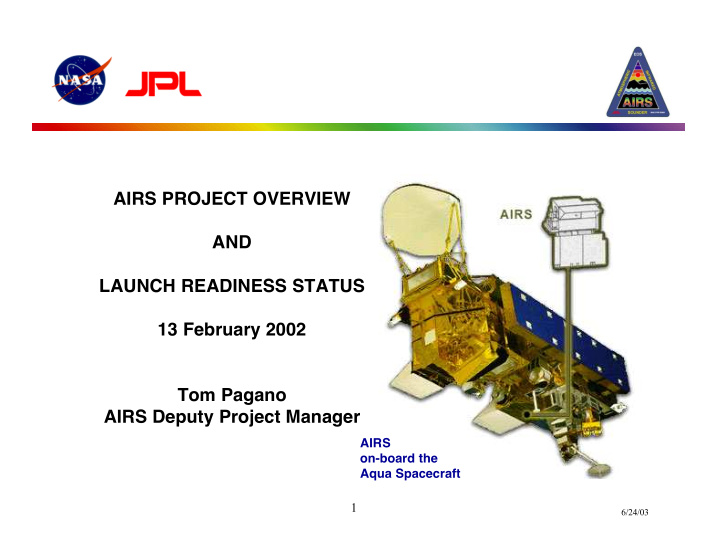



AIRS PROJECT OVERVIEW AND LAUNCH READINESS STATUS 13 February 2002 Tom Pagano AIRS Deputy Project Manager AIRS on-board the Aqua Spacecraft 1 6/24/03
AIRS PROJECT PARTICIPATION AIRS is the Atmospheric Infrared Sounder • Sponsored by NASA Office of Earth Science • Managed by JPL, NASA, California Institute of Technology • Instrument built by BAE Systems in Lexington Ma. • Science Participants include • NASA JPL, GSFC, LaRC • NOAA/NESDIS • MIT/LL • ECMWF • UMBC, UW/SSEC, UCSB • and many others • 2 6/24/03
AQUA SPACECRAFT NEARLY READY FOR SHIP TO WTR AIRS will fly on the Earth • Observing System (EOS) “Aqua” spacecraft AIRS ON Aqua to be launched from • AQUA Vandenburg April 18, 2002 S/C Status • PSR February 5-6, 2002 • Ship to WTR Feb 22, 2002 • Orbit: 705 km, polar sun • synchronous, ascending 1:30 PM ect Companion instruments • AMSR-E • AMSU-A (Advanced Microwave Sounding • Unit - A) HSB (Humidity Sounder for Brazil) • CERES • MODIS • 3 6/24/03
AIRS IS READY FOR LAUNCH • Two thermal vacuum cycles at BAE Systems • Delivered to Spacecraft in November 1999 • Environmental Testing • Comprehensive Functional and Performance Testing • All command sequences and databases demonstrated end-to-end • AIRS Launch Readiness Review • Jan. 29, 2002 • Independent Review Board • No Liens on AIRS Hardware AIRS Requirements • All P/FRs resolved Instantaneous Field of View : 1.1° x 0.6° (13.5 km x 7.4 km) • Scan Range: ±49.5° • IR Spectral Range: 3.74-4.61 µm, 6.2-8.22 µm, 8.8-15.4 µm • IR Spectral Resolution: ≈ 1200 ( l/Dl ) • Number of IR Channels: 2378 IR • VIS Channels: 4 (0.41-0.44 µm, 0.58-0.68 µm, 0.71-0.92 µm, 0.49-0.94 µm) • VIS Spatial Resolution: 0.14° (1.7 km) • Mass: 177Kg, Power: 256 Watts, Life: 5 years (7 years goal) • 4 6/24/03
POST-LAUNCH OPERATIONS READY FOR LAUNCH AIRS operations manual complete • In-Flight operational timeline developed • All procedures and databases complete • SCIF 4 Run for Record Scheduled 2/7/02 • Critical operations constraints and rules defined • Anomaly investigation plan in place • Operation teams defined: AIRS, AMSU, HSB • Tested every command and every procedure we anticipate • using in orbit. No Liens. 5 6/24/03
AIRS CALIBRATION READY Radiometric linearity and OBC BB calibration completed • with accuracies less than ±0.2K at 265K for all channels Spectral accuracies better than 1% ∆ l • Channel spectra in-flight characterization approach verified • All in-flight special calibration sequences (SCS) (11) • demonstrated at TRW L1B calibrated radiances algorithms and software in final • verification Long term calibration and high rate telemetry trending • software in place 6 6/24/03
SCIENCE DATA PROCESSING SYSTEM READY FOR LAUNCH Launch-ready SPS software has been delivered to GSFC • DAAC Data from TRW warm test and TVAC tests Processed at JPL • TDS with no major problems Launch-ready PGEs most recently tested during MOSS 6 • testing at JPL TDS and GSFC DAAC Operational Loading Test in TDS underway • A schedule exists for post-launch delivery of production • level code to the GSFC DAAC 7 6/24/03
AMSU/HSB SUITE READY FOR LAUNCH AMSU-A1 HSB AMSU-A2 Instruments Ready • No Hardware Liens Per Aerojet and INPE • Calibration Complete • Science Data Processing System Ready • Demonstrated using sim and T/V data • QA Post Processing and Analysis Launch • Ready 8 6/24/03
CONCLUSIONS AIRS Experiment ready for Launch • Instrument functioning extremely well; no hardware liens. • Instrument well characterized from pre-launch TVAC testing • Passed all Environmental Tests • Performed Flawlessly in Thermal Vacuum at TRW • Exceptional performance and sensitivity in flight like environment; no • influence from the spacecraft (WYSIWYG) Operations procedures developed and fully tested to safely activate • and operate the instruments Science Data Processing System has been delivered to GSFC DAAC • and flow testing has been demonstrated. Acknowledgements • For more information see www-airs.jpl.nasa.gov • 9 6/24/03
BACKUP 10 6/24/03
AIRS/AMSU/HSB DATA FLOW AIRS International NOAA BUFR NOAA AMSU NCEP Weather NESDIS w/GSFC HSB Centers JPL L1B Quicklook HR L0 Matchup ESDIS Data L1A, L1B LR and HR L0 L2, L3 GSFC DAAC OUTSIDE DAAC ARCHIVE USERS GSFC OPS QA QA LR CCB Cmds Telem PGEs IF Cal JPL AIRS Reqmts L1A/L1B L2 PGEs JPL JPL JPL Science Science OPS/ENG CAL TDS Implement. Team L2 Reqmts •Create Procs/Cmds •Cal Tables •PGE Integration •L1A L1B Dev L2 Dev •Schedule Events •Cal Algorithms •PGE Testing •L2 Integration L2 Test/Validation •Monitor Instruments •L1B Reqmts •Data Archive/ •L2 Test/Validation •Anomaly Resolution •L1A L1B Test/Val Distribution •L3 Development •Documentation •Cal/HRE Trending •(1st year) 11 6/24/03
AIRS TECHNOLOGY IR Spectrometer: Multi-Aperture • Array Grating Spectrometer Spectrometer Cooling to 155K with • Two-Stage Passive Radiator Focal Plane Cooling using Single • Stage Stirling Pulse Tube, Redundant FPAs: PV HgCdTe to 13.7 µm, PC • HgCdTe to 15.4 µm On-Board Calibration Views: Space, • Blackbody, Parylene (Spectral), 3 VIS/NIR Lamps Electronics Architecture: • Dual Redundant/µ-processor • controlled On-board radiation circumvention • signal processing 12 6/24/03
Recommend
More recommend